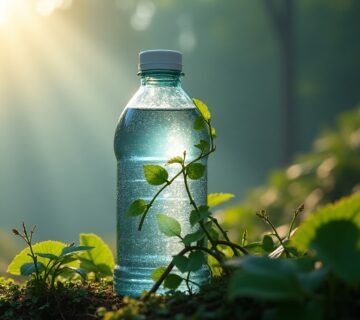Many standards have been established and approved for the production of food and beverages and drinking water. Since food and water items are among the sensitive consumables in human life, there are extensive laws and standards governing their production. If these substances contain contamination or a large amount of impurities, it could lead to the outbreak of diseases and even widespread mortality in the world. Mineral water, as the most important and vital food item in the world, is not exempt from this rule. We are all aware of the benefits and necessity of using mineral water, but what points should we consider when preparing and producing this substance?
What regulations and standards should a company or manufacturer adhere to in order to provide healthy and palatable water to its customers? In the following sections of this article, we will comprehensively address these questions.

Types of drinking water
Before discussing the international and main standards for mineral water production, we should briefly talk about the types of it. Generally, there are three methods to obtain that:
Pipeline water
Treated water (filtered through home filters)
Bottled mineral water available in the market
This is distributed and supplied in society through these three methods. Now, how is this obtained? It comes from underground sources, surface, and the liquid from snow and rain, which vary in mineral content depending on their different conditions.
Main standards for mineral water production
In both treated and untreated solutions, several different substances and elements can be found. The difference between the two is in the quantity and concentration of these minerals in the liquid, which can be altered using various industrial equipment, ultimately producing potable liquid. The role of regulations and standards is to indicate the correct amounts of these substances. There are several general rules around the world, and a few international organizations have published their rules and regulations. These include:
• Codex Alimentarius Standard (Codex CAC/RCP 33)
• European Union Standards (Directive 2009/54/EC)
• U.S. Food and Drug Administration (FDA) Regulations
• Quality and Safety Management Standards (ISO 9001 and ISO 22000)
• World Health Organization (WHO) Guidelines for Drinking Water Quality

Codex Alimentarius Standard
These international rules are recommended as one of the references for producing natural mineral waters and aims to preserve the natural mineral compositions without the use of chemical processes. From the perspective of the Codex Alimentarius, the source of water should be from natural resources such as underground springs, and no chemical additives should be present in its composition.
Only physical operations such as aeration, which are used to remove unnecessary gases like carbon dioxide, as well as filtration, which is used to eliminate suspended particles and microorganisms, are allowed in the production process. The permissible limits for various elements in water are as follows:
• Arsenic: ≤ 0.01 milligrams per liter
• Cadmium: approximately 0.003 milligrams per liter
• Mercury: generally around 0.001–0.006 milligrams per liter
• Main compounds such as calcium, magnesium, sodium, and hydrocarbons should also be maintained at natural levels.
Other Requirements
• pH: Maintain a range that indicates the natural state of water (generally between 6.5 to 8.5, but the emphasis is on not changing from the source).
• Clarity, color, and odor: Water should be free of undesirable color, odor, or taste.
• Microbiology: Elimination or minimization of microbial contaminants; for example, the absence of contamination by E. coli or other pathogenic bacteria.
EU Standards
The European Union has established specific rules and standards for its member countries, and both domestic producers and products entering these countries must comply with these regulations; otherwise, their entry and use will be prohibited. These regulations indicate that water extraction must be done directly from the source and packaged on-site, and any process that causes significant changes in the solution is prohibited. Precise numerical limits have been set for various elements and compounds. For example (with a comparison of different standards that are generally similar):
| Table | |
|---|---|
| Arsenic: | ≤ 0.01 mg/L |
| Chromium: | ≤ 0.05 mg/L |
| Cadmium: | approx. 0.003–0.005 mg/L |
| Nitrate: | ≤ 50 mg/L |
| Sodium: | approx. 200–250 mg/L |
| Fluoride: | ≤ 1.5 mg/L |
| Total hardness: | approx. 200 mg/L |
| Calcium: | approx. 300 mg/L |
Microbiological Parameters
Compliance with strict microbiological standards so that the water is free of pathogenic bacteria and viruses.
Packaging and Labeling
Inclusion of information about the source, mineral composition (detailed in milligrams per liter), and relevant production and expiration dates.
US FDA Standards
Like the EU, the United States has established specific rules and regulations that include the production stages of bottled water and the packaging process.
Microbiological Parameters
Absence of dangerous microbial contaminants such as E. coli and other pathogenic bacteria.
Chemical Parameters
- Establishing permissible limits for chemical pollutants; the allowable amounts for heavy metals (such as arsenic, cadmium, mercury, etc.) are at levels similar to those of other international standards.
- Regulation of pH of water; generally, it should have a pH between 6.5 and 8.5.
Production and Packaging Control
- Adherence to sanitary conditions at all stages of production (from extraction to purification to packaging).
- Accurate record-keeping, quality monitoring of equipment, and compliance with sanitary standards in production lines.
Labeling
Inclusion of complete specifications such as the source of water, production and expiration dates, and information related to the chemical composition of the it.
ISO 9001 and ISO 22000 Standards
These two are among the most frequently used and important international laws that most producers follow. Further explanations of each will be provided.
ISO 9001 (Quality Management)
This standard, known as quality control, is responsible for ensuring that the production process is continuously improved and has acceptable stability.
The parameters of this include:
- Precise control of the production and packaging process
- Recording and documenting processes, performance evaluation, and periodic reviews.
- Ensuring compliance with health and quality standards at all stages from extraction to distribution.
ISO 22000 (Food Safety Management)
It ensures food safety and health by identifying and controlling various hazards.
The parameters of this standard include:
- Implementation of Hazard Analysis Critical Control Point (HACCP) systems and determining Critical Control Points (CCP) in the production process.
- Continuous monitoring of processes and documenting corrective actions in case of problems.
- Ensuring equipment hygiene, staff training, and quality assurance at all production stages.
World Health Organization (WHO) Standards
The World Health Organization, as one of the largest and most reputable international organizations in the field of food and health care, has established numerous regulations regarding the production of drinkable mineral water. You can read all these standards through this link .Below we will address some of these standards.
Chemical Parameters
Specific limits for contaminant elements such as:
Arsenic: ≤ 0.01 mg/L
Nitrates: ≤ 50 mg/L
Cadmium and Mercury: at very low levels (approximately 0.003–0.006 mg/L respectively)
Determination of permissible limits for other salts and ions (such as fluoride, sodium, total hardness, and calcium) based on safety assessments.
Microbiological Parameters
Determination of microbiological indicators such as the total number of culturable bacteria (HPC) and the absence of safety-related contaminants like E. coli.
Physical Parameters
pH regulation (usually in the range of 6.5 to 8.5), turbidity (clarity), and its temperature.

Conclusion
Drinking water has always been one of the most important food commodities for humans. For many years, humans have suffered from the lack of such a blessing and, due to inadequate facilities, we have witnessed the spread of various diseases among individuals. However, thanks to advancements of science and technology, the production of standard drinking water has become possible.
In this article, we discussed what parameters a mineral water producer should follow in their production to deliver a suitable and healthy product to the consumer market. According to various sources, these regulations are quite extensive, and it is up to the producer to decide which source to adhere to.
If you need consultation and guidance for ordering or purchasing mineral water packaging, you can connect with our experts via this link.




No comment